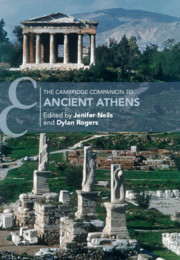Book contents
- The Cambridge Companion to Ancient Athens
- Cambridge Companions to the Ancient World
- The Cambridge Companion to Ancient Athens
- Copyright page
- Contents
- Contributors
- Abbreviations
- Athens: An Introduction
- 1 #Leagros: An Athenian Life
- Part I The Urban Fabric
- 2 Asty and Chora: City and Countryside
- 3 The Emergence of the Polis
- 4 City Streets, Walls, and Gates
- 5 The Akropolis
- 6 The Agora: Public Life and Administration
- 7 Athenian Inscriptions
- 8 Water and Water Management
- 9 Housing and the Household
- 10 The Archaic and Classical Cemeteries
- Part II Inhabitants
- Part III Business/Commerce
- Part IV Culture and Sport
- Part V Politics
- Reception
- Index
- References
10 - The Archaic and Classical Cemeteries
from Part I - The Urban Fabric
Published online by Cambridge University Press: 10 March 2021
- The Cambridge Companion to Ancient Athens
- Cambridge Companions to the Ancient World
- The Cambridge Companion to Ancient Athens
- Copyright page
- Contents
- Contributors
- Abbreviations
- Athens: An Introduction
- 1 #Leagros: An Athenian Life
- Part I The Urban Fabric
- 2 Asty and Chora: City and Countryside
- 3 The Emergence of the Polis
- 4 City Streets, Walls, and Gates
- 5 The Akropolis
- 6 The Agora: Public Life and Administration
- 7 Athenian Inscriptions
- 8 Water and Water Management
- 9 Housing and the Household
- 10 The Archaic and Classical Cemeteries
- Part II Inhabitants
- Part III Business/Commerce
- Part IV Culture and Sport
- Part V Politics
- Reception
- Index
- References
Summary
This chapter details the distribution and organization of cemeteries along roads leading out of the ancient city walls and provides an overview of the monuments that adorned burials and plots. In addition, the various types of industrial workshops, sanctuaries, and other structures that populated these cemeteries are discussed.
- Type
- Chapter
- Information
- The Cambridge Companion to Ancient Athens , pp. 140 - 156Publisher: Cambridge University PressPrint publication year: 2021
References
Further Reading
The study of Athenian cemeteries continues to be a vibrant field of study. For a recent overview of Athenian cemeteries in the Early Iron Age and Archaic periods, see Dimitriadou 2019. For the Classical cemeteries, see Morris 1992, Parlama and Stampolidis 2000, Marchiandi 2011, and Stroszeck 2017. For the study of cemetery management and the procurement of burial plots see Zelnick-Abramovitz 2015. For comprehensive collections of Classical tombstones, Clairmont 1993 and Bergemann 1997 and 2001 are good places to begin, but Conze’s multi-volume study (1893–1911) is still useful today. For tombstones that have been found more recently in rescue excavations, see Bardani and Papadopoulos 2006. For painted tombstones, see Posamentir 2006. For an overview of the public cemetery and the monuments associated with it, see Arrington 2010 and 2015.
Bibliography
Additional resources to accompany this chapter can be found at: www.cambridge.org/NeilsRogers



